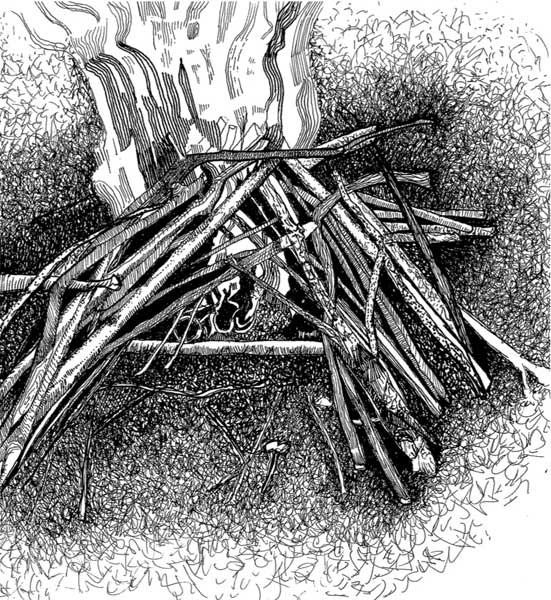Get Back: A warm glow in the woods
A monthly series following Rob Cowen and Leo Critchley as they reconnect with the simpler things in life

Fire was once our "killer app", our greatest technology. It brought light, warmth, safety, new foods and the origins of society. Small wonder that, if done responsibly, nothing beats the joy of rekindling the spark that lit our evolution. English woodland burns like a damp sponge, so there is no shame in using a match or lighter – our ancestors would have jumped at the chance.
In a sheltered spot, create a 30cm square platform of even-length sticks at the centre of a 2m circle cleared down to the bare earth. The tinder must be dry and have plenty of surface area. Silver birch bark is often available, and it burns as well as any synthetic firelighter.
Once the platform is built, tear the bark into shreds and place a good couple of handfuls on to the platform. Add two handfuls of kindling to keep it in place. This should be matchstick-thick dry wood, around 30cm long. Interlock these twigs either side of the birch bark to create an arrowhead shape that points the same direction the breeze is blowing.
Progress to wood that is pencil-thickness and so on, doubling the width each time until your fuel is about half the span of your wrist and your arrowhead heap reaches a height of around 25cm. Work the point of the arrowhead back to shelter the tinder, but leave enough space to light it.
Done properly, it should only ever take one rasp of a lighter's wheel or a single matchstick. A more traditional approach, with flint and firesteel, will likely take longer as the sparks are much cooler. From the moment the birch bark ignites, the world stills. You should do the same. A young fire is like an eye; prod it and it will blink and close. Left alone, it will open and take in its surroundings.
It was fitting for this oldest of rituals that we were an arrow's shot from Arundel Castle in West Sussex. The ancient wood glowed as though smouldering; the orchids and violets were dappled with rays of late-afternoon sun that still had the energy to pierce the canopies of oak and lime. Before us, the flames of our little arrow fire were a busy quickstep within the light's gentle waltz, calming and entrancing us. Flickering and growing, they let out a hiss and crackle as the wood took and the smoke thickened. Suddenly, the breeze lifted and the arrow's tip was fully ablaze, igniting in us a similar whoosh of elation.
Fire was first and foremost a tool. We put ours to a multitude of uses. Flattening some ash and charcoal to one side created a rudimentary hob to boil a kettle. Over the livelier half of the fire, flames licked two stick-speared steaks, expertly foraged from Tesco. We took turns to fetch wood, using the glow as a lighthouse as we swam back through the dark sea of trees. Under a canopy of stars, we rolled out sleeping bags and watched the flames.
By morning the fire was cold, but we poured water over it to make sure, scattered the ash and covered the bare earth with damp leaves. Through a simple campfire, we had drawn closer to nature and our own, primitive, natures. We left the wood as we had found it, but something in us had changed.
Hot spots: Campsites that allow fires
Always get the landowner's permission before lighting any fire. Alternatively, you can spend a night at one of Britain's many campsites that welcome a campfire:
* Red Squirrel Campsite, Glencoe, Scotland
Forage for wood and light your fire in a wide expanse of forested camping alongside the River Coe, with its own swimming hole and fishing rights: 01855 811256; redsquirrelcampsite.com.
* Low Greenside Farm, Cumbria, England
Fire is prohibited in the Lake District National Park itself, but this quiet campsite on a sheep farm is close by and has cracking views of the Howgill Fells: 01539 623 217.
* Tresseck Campsite, Herefordshire, England
This family campsite in the heart of the Wye Valley is perfect for canoeing, fishing and making campfires: 01432 840235; tresseckcampsite.co.uk.
* Nantcol Campsite, Snowdonia, Wales
The seven acres of flat ground here are at the foot of the Rhinog Mountain range and only two miles from the sands of Shell Island: 01341 241 209; nantcolwaterfalls.co.uk/camping.html.
More campfire-friendly sites: www.thehappycampers.co.uk
Subscribe to Independent Premium to bookmark this article
Want to bookmark your favourite articles and stories to read or reference later? Start your Independent Premium subscription today.

Join our commenting forum
Join thought-provoking conversations, follow other Independent readers and see their replies